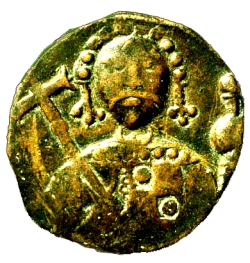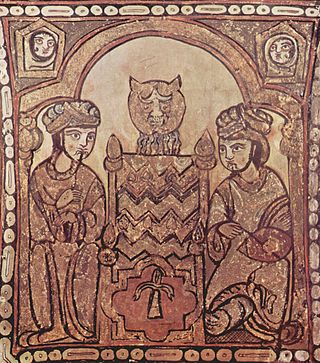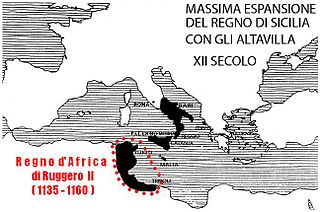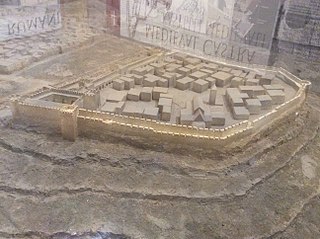Related Research Articles

Robert "Guiscard" de Hauteville, sometimes Robert "the Guiscard", was a Norman adventurer remembered for his conquest of southern Italy and Sicily in the 11th century.

Roger I, nicknamed “Roger Bosso” and “Grand Count Roger”, was a Norman nobleman who became the first Grand Count of Sicily from 1071 to 1101.

The Zirid dynasty, Banu Ziri, was a Sanhaja Berber dynasty from what is now Algeria which ruled the central Maghreb from 972 to 1014 and Ifriqiya from 972 to 1148.

The Kalbids were a Muslim Arab dynasty in the Emirate of Sicily, which ruled from 948 to 1053. They were formally appointed by the Fatimids, but gained, progressively, de facto autonomous rule.

The Mahdia campaign of 1087 was a raid on the North African town of Mahdia by armed ships from the northern Italian maritime republics of Genoa and Pisa.

The Emirate of Sicily or Fatimid Sicily was an Islamic kingdom that ruled the Muslim territories on the island of Sicily between 831 and 1091. Its capital was Palermo, which, during this period, became a major cultural and political center of the Muslim world.

George of Antioch was the first to hold the office of ammiratus ammiratorum in the Norman Kingdom of Sicily. He was a Syrian-born Byzantine Christian of Greek ancestry. He was born in Antioch, whence he moved with his father, Michael, and mother to Tunisia following the First Crusade. He found employment under the Zirid emir, Tamim ibn Muizz, rising to the position of governor of the city of Sousse. George fell out with Tamim's son and successor, Yahya, and secretly left for Christian Sicily by stealing away in disguise aboard a Palermitan ship harbored in Mahdia. Upon arrival in the Sicilian capital, George went immediately to the palace and found service with the Norman count, Roger II.

The House of Hauteville was a Norman family originally of seigneurial rank from the Cotentin. The Hautevilles rose to prominence through their part in the Norman conquest of southern Italy. By 1130, one of their members, Roger II, was made the first King of Sicily. His male-line descendants ruled Sicily until 1194. Some Italian Hautevilles took part in the First Crusade and the founding of the Principality of Antioch (1098).

Cerami is a comune in Sicily, southern Italy, part of the Province of Enna. The town itself is perched on a mountaintop 1,000 metres (3,300 ft) above sea level. A river also named Cerami flows through this area.

The history of Islam in Sicily and southern Italy began with the first Arab settlement in Sicily, at Mazara, which was captured in 827. The subsequent rule of Sicily and Malta started in the 10th century. The Emirate of Sicily lasted from 831 until 1061, and controlled the whole island by 902. Though Sicily was the primary Muslim stronghold in Italy, some temporary footholds, the most substantial of which was the port city of Bari, were established on the mainland peninsula, especially in mainland southern Italy, though Muslim raids, mainly those of Muhammad I ibn al-Aghlab, reached as far north as Naples, Rome and the northern region of Piedmont. The Arab raids were part of a larger struggle for power in Italy and Europe, with Christian Byzantine, Frankish, Norman and local Italian forces also competing for control. Arabs were sometimes sought as allies by various Christian factions against other factions.

The Muslim conquest of Sicily began in June 827 and lasted until 902, when the last major Byzantine stronghold on the island, Taormina, fell. Isolated fortresses remained in Byzantine hands until 965, but the island was henceforth under Muslim rule until conquered in turn by the Normans in the 11th century.

The Norman conquest of southern Italy lasted from 999 to 1194, involving many battles and independent conquerors.

Ibn Ḥamdīs al-ʾAzdī al-Ṣīqillī was a Sicilian Arab poet.

The term Norman–Arab–Byzantine culture, Norman–Sicilian culture or, less inclusively, Norman–Arab culture, refers to the interaction of the Norman, Byzantine Greek, Latin, and Arab cultures following the Norman conquest of the former Emirate of Sicily and North Africa from 1061 to around 1250. The civilization resulted from numerous exchanges in the cultural and scientific fields, based on the tolerance shown by the Normans towards the Latin- and Greek-speaking Christian populations and the former Arab Muslim settlers. As a result, Sicily under the Normans became a crossroad for the interaction between the Norman and Latin Catholic, Byzantine–Orthodox, and Arab–Islamic cultures.

The County of Sicily, also known as County of Sicily and Calabria, was a Norman state comprising the islands of Sicily and Malta and part of Calabria from 1071 until 1130. The county began to form during the Christian reconquest of Sicily (1061–91) from the Muslim Emirate, established by conquest in 965. The county is thus a transitional period in the history of Sicily. After the Muslims had been defeated and either forced out or incorporated into the Norman military, a further period of transition took place for the county and the Sicilians.

The Kingdom of Africa was an extension of the frontier zone of the Kingdom of Sicily in the former Roman province of Africa, corresponding to Tunisia and parts of Algeria and Libya today. The main primary sources for the kingdom are Arabic (Muslim); the Latin (Christian) sources are scanter.

The Battle of Cerami was fought in June 1063 and was one of the most significant battles in the Norman conquest of Sicily, 1060–1091. The battle was fought between a Norman expeditionary force and a Muslim alliance of Sicilian and Zirid troops. The Normans fought under the command of Roger de Hauteville, the youngest son of Tancred of Hauteville and brother of Robert Guiscard. The Muslim alliance consisted of the native Sicilian Muslims under the Kalbid ruling class of Palermo, led by Ibn al-Hawas, and Zirid reinforcements from North Africa led by the two princes, Ayyub and 'Ali. The battle was a resounding Norman victory that utterly routed the opposing force, causing divisions amongst the Muslim aristocracy which ultimately paved the way for the eventual capture of the Sicilian capital, Palermo, by the Normans and subsequently the rest of the island.

The Norman invasion of Malta was an attack on the island of Malta, then inhabited predominantly by Muslims, by forces of the Norman County of Sicily led by Roger I in 1091. The invaders besieged Medina, the main settlement on the island, but the inhabitants managed to negotiate peace terms. The Muslims freed Christian captives, swore an oath of loyalty to Roger and paid him an annual tribute. Roger's army then sacked Gozo and returned to Sicily with the freed captives.
The Zirid raid on Gabès was a military operation launched by the Zirids against the Norman governor of Gabès to try and reassert their dominance in Ifriqiya.
The capture of Palermo by the Zirids in 1036 marked a pivotal moment, establishing their suzerainty over the island. This clash unfolded between the Kalbid Emir Ahmad ben Yousouf Al Akhal, the reigning sovereign of the island, and the forces dispatched by the Zirid Emir Al Muiz Ibn Badis. This event transpired within the backdrop of the Kalbid dynasty's decline, plagued by repeated setbacks in their encounters with the Byzantines.
References
- 1 2 "The Rulers of the South • The Normans (Part 2 of 3)". penelope.uchicago.edu. Retrieved 2021-02-06.
- 1 2 "The Norman Conquest of Muslim Sicily". ResearchGate. Retrieved 2021-02-06.
- ↑ "Gnuni - Gran Conte Ruggero D'Altavilla". www.gnuni.com. Retrieved 2021-02-06.